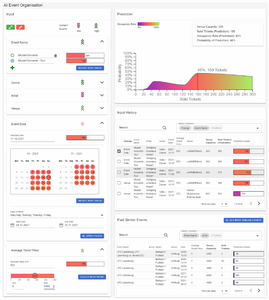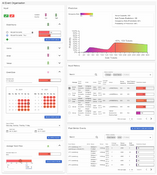Information
- Publication Type: Master Thesis
- Workgroup(s)/Project(s):
- Date: November 2021
- Date (Start): November 2020
- Date (End): November 2021
- TU Wien Library:
- Second Supervisor: Eduard Gröller
- Diploma Examination: 15. November 2021
- Open Access: yes
- First Supervisor: Manuela Waldner
- Pages: 110
- Keywords: machine learning, interactive visualisation
Abstract
In recent years, the usage of machine learning (ML) models and especially deep neural networks in many different domains has increased rapidly. One of the major challenges when working with ML models is to correctly and efficiently interpret the results given by a model. Additionally, understanding how the model came to its conclusions can be a very complicated task even for domain experts in the field of machine learning. For laypeople, ML models are often just black-boxes. The lack of understanding of a model and its reasoning often leads to users not trusting the model’s predictions.In this thesis, we work with an ML model trained on event-organisation data. The goal is to create an exploratory visual event-organisation system that enables event organisers to efficiently work with the model. The main user goals in this scenario are to maximise profits and to be able to prepare for the predicted number of visitors. To achieve these goals users need to be able to perform tasks like: interpreting the prediction of the current input and performing what-if analyses to understand the effects of changing parameters. The proposed system incorporates adapted versions of multiple state-of-the-art model-agnostic interpretation methods like partial dependence plots and case-based reasoning. Since model-agnostic methods are independent of the ML model, they provide high flexibility.
Many state-of-the-art approaches to explain ML models are too complex to be understood by laypeople. Our target group of event organisers cannot be expected to have a sufficient amount of technical knowledge in the field of machine learning. In this thesis, we want to find answers to the questions: How can we visualise ML predictions to laypeople in a comprehensible way? How can predictions be compared against each other? How can we support users in gaining trust in the ML model? Our event-organisation system is created using a human-centred design approach performing multiple case studies with potential users during the whole development circle.
Additional Files and Images
Weblinks
- Entry in reposiTUm (TU Wien Publication Database)
- Entry in the publication database of TU-Wien
- DOI: 10.34726/hss.2021.85640
BibTeX
@mastersthesis{sbardellati-2021-eveos,
title = "Exploratory Visual System for Predictive Machine Learning of
Event-Organisation Data",
author = "Maximilian Sbardellati",
year = "2021",
abstract = "In recent years, the usage of machine learning (ML) models
and especially deep neural networks in many different
domains has increased rapidly. One of the major challenges
when working with ML models is to correctly and efficiently
interpret the results given by a model. Additionally,
understanding how the model came to its conclusions can be a
very complicated task even for domain experts in the field
of machine learning. For laypeople, ML models are often just
black-boxes. The lack of understanding of a model and its
reasoning often leads to users not trusting the model’s
predictions. In this thesis, we work with an ML model
trained on event-organisation data. The goal is to create an
exploratory visual event-organisation system that enables
event organisers to efficiently work with the model. The
main user goals in this scenario are to maximise profits and
to be able to prepare for the predicted number of visitors.
To achieve these goals users need to be able to perform
tasks like: interpreting the prediction of the current input
and performing what-if analyses to understand the effects of
changing parameters. The proposed system incorporates
adapted versions of multiple state-of-the-art model-agnostic
interpretation methods like partial dependence plots and
case-based reasoning. Since model-agnostic methods are
independent of the ML model, they provide high flexibility.
Many state-of-the-art approaches to explain ML models are
too complex to be understood by laypeople. Our target group
of event organisers cannot be expected to have a sufficient
amount of technical knowledge in the field of machine
learning. In this thesis, we want to find answers to the
questions: How can we visualise ML predictions to laypeople
in a comprehensible way? How can predictions be compared
against each other? How can we support users in gaining
trust in the ML model? Our event-organisation system is
created using a human-centred design approach performing
multiple case studies with potential users during the whole
development circle.",
month = nov,
pages = "110",
address = "Favoritenstrasse 9-11/E193-02, A-1040 Vienna, Austria",
school = "Research Unit of Computer Graphics, Institute of Visual
Computing and Human-Centered Technology, Faculty of
Informatics, TU Wien",
keywords = "machine learning, interactive visualisation",
URL = "https://www.cg.tuwien.ac.at/research/publications/2021/sbardellati-2021-eveos/",
}

 poster
poster thesis
thesis


